SML3893
LCL521 dihydrochlroide

≥95% (HPLC)
Sinónimos:
(1R,2R)-2-N-(Tetradecanoylamino)-1-(40-nitrophenyl)-propyl-1,3-O,O-di-(N,N-dimethylamino) acetate dihydrochloride, 1,3-DMG-B13, 1,3-O,O-DMG-B13•2HCl, 1,3-di-DMG-B13, B13: (1R,2R)-2-(tetradecanoylamino)-1-(4′-nitrophenyl)-1,3-propandiol), LCL 521, LCL-521
About This Item
Productos recomendados
Quality Level
assay
≥95% (HPLC)
form
powder
storage condition
desiccated
color
white to beige
solubility
DMSO: 2 mg/mL, clear
storage temp.
-10 to -25°C
SMILES string
CN(C)CC(O[C@H](C1=CC=C(C=C1)[N+]([O-])=O)[C@@H](COC(CN(C)C)=O)NC(CCCCCCCCCCCCC)=O)=O.[2HCl]
Biochem/physiol Actions
LCL521 is the N,N-dimethyl glycine (DMG) diester prodrug form of the selective acid ceramidase (ACDase) inhibitor B13 (no inhibition against NCDase/ASAH2 or AlkCDase/ACER2). The DMG enables efficient and targeted B13 lysosomal delivery, resulting in enhanced cellular ACDase inhibitory potency (by 70% vs 12% in MCF7, respectively, post 1h treatment by 1 μM LCL521 or 10 μM B13) and effective blockage of ceramide (Cer) to sphingosine (Sph) processing (80% vs 0% Sph level drop in MCF7, respectively, post 1h treatment by 1 μM LCL521 or 10 μM B13).
Caution
Storage Class
11 - Combustible Solids
wgk_germany
WGK 3
flash_point_f
Not applicable
flash_point_c
Not applicable
Certificados de análisis (COA)
Busque Certificados de análisis (COA) introduciendo el número de lote del producto. Los números de lote se encuentran en la etiqueta del producto después de las palabras «Lot» o «Batch»
¿Ya tiene este producto?
Encuentre la documentación para los productos que ha comprado recientemente en la Biblioteca de documentos.
Nuestro equipo de científicos tiene experiencia en todas las áreas de investigación: Ciencias de la vida, Ciencia de los materiales, Síntesis química, Cromatografía, Analítica y muchas otras.
Póngase en contacto con el Servicio técnico








